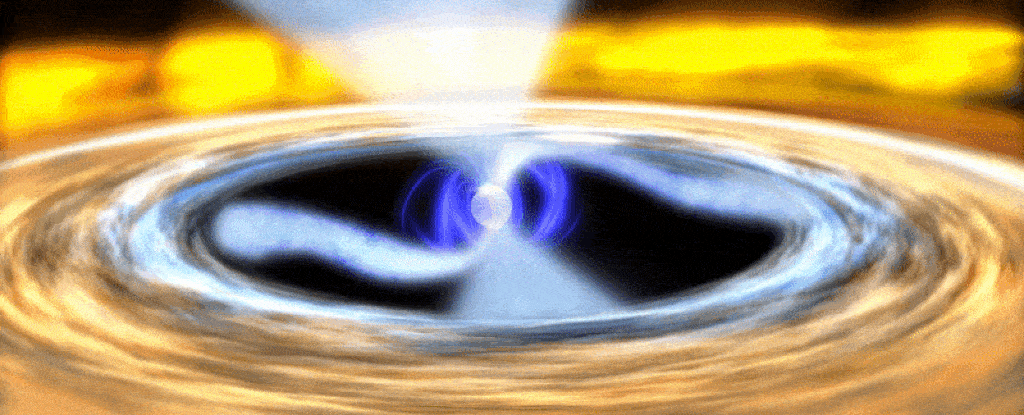Not much can be accomplished in a few hundred milliseconds. Yet for the neutron stars seen in the glints of two gamma-ray bursts, it's more than enough time to teach us a thing or two about life, death, and the birth of black holes.
Sifting through an archive of high-energy flashes in the night sky, astronomers recently uncovered patterns in the oscillations of light left by two different sets of colliding stars, indicating a pause on their journey from super-dense object to infinite pit of darkness.
That pause – somewhere between 10 and 300 milliseconds – technically equates to two newly formed, mega-sized neutron stars, which researchers suspect were each spinning fast enough to briefly hold off their inevitable fates as black holes.
"We know that short GRBs form when orbiting neutron stars crash together, and we know they eventually collapse into a black hole, but the precise sequence of events is not well understood," says Cole Miller, an astronomer at the University of Maryland, College Park (UMCP) in the US.
"We found these gamma-ray patterns in two bursts observed by Compton in the early 1990s."
For nearly 30 years, the Compton Gamma Ray Observatory circled Earth and collected the shine of X-rays and gamma rays that spilled from distant cataclysmic events. That archive of high energy photons contains a trove of data on things like colliding neutron stars, which release powerful pulses of radiation known as gamma-ray bursts.
Neutron stars are true beasts of the cosmos. They pack double the mass of our Sun inside a volume of space roughly the size of a small city. Not only does this do weird things to matter, forcing electrons into protons to turn them into a heavy dusting of neutrons, it can generate magnetic fields unlike anything else in the Universe.
Spun into high rotation, these fields can accelerate particles to ridiculously high velocities, forming polar jets that appear to 'pulse' like supercharged lighthouses.
Neutron stars are formed as more ordinary stars (around 8 to 30 times the mass of our Sun) burn off the last of their fuel, leaving a core of around 1.1 to 2.3 solar masses, too cold to resist the squeeze of its own gravity.
Add a little more mass – such as by cramming two neutron stars together – and not even the lackluster jiggling of its own quantum fields can resist gravity's urge to crush the living physics out of the dead star. From a dense blob of particles we get, well, whatever the unspeakable horror is that happens to be the heart of a black hole.
The basic theory on the process is pretty clear, setting general limits on just how heavy a neutron star can be before it collapses. For cold, non-rotating balls of matter, this upper boundary is just under three solar masses, but that also implies complications that just might make the journey from neutron star to black hole less than straightforward.
For example, earlier last year physicists announced the observation of a burst of gamma-rays dubbed GRB 180618A, detected back in 2018. In the afterglow of the burst they detected the signature of a magnetically-charged neutron star called a magnetar, one with a mass close to that of the two colliding stars.
Barely a day later this heavyweight neutron star was no more, no doubt succumbing to its extraordinary mass and transforming into something not even light can escape from.
How it managed to resist gravity for as long as it did is a mystery, though its magnetic fields may have played a role.
These two new discoveries could also provide a few clues.
The more accurate term for the pattern observed in the gamma-ray bursts recorded by Compton in the early 1990s is a quasiperiodic oscillation. The mix of frequencies that rise and fall in the signal can be deciphered to describe the final moments of massive objects as they circle one another and then collide.
From what the researchers can tell, the collisions each produced an object around 20 percent larger than the current record-holder heavyweight neutron star – a pulsar calculated at 2.14 times the mass of our Sun. They were also twice the diameter of a typical neutron star.
Interestingly, the objects were rotating at an extraordinary pace of nearly 78,000 times a minute, far faster than the record-holding pulsar J1748–2446ad, which manages a mere 707 turns a second.
The few rotations each neutron star managed to pull off in its brief lifetime of a fraction of a second could have been powered by just enough angular momentum to combat their gravitational implosion.
How this may apply to other neutron star mergers, further blurring the boundaries of stellar collapse and black hole generation, is a question for future research.
This research was published in Nature.
